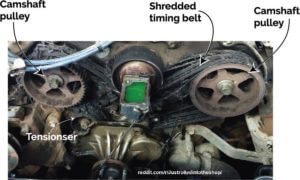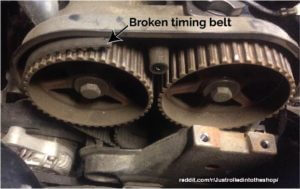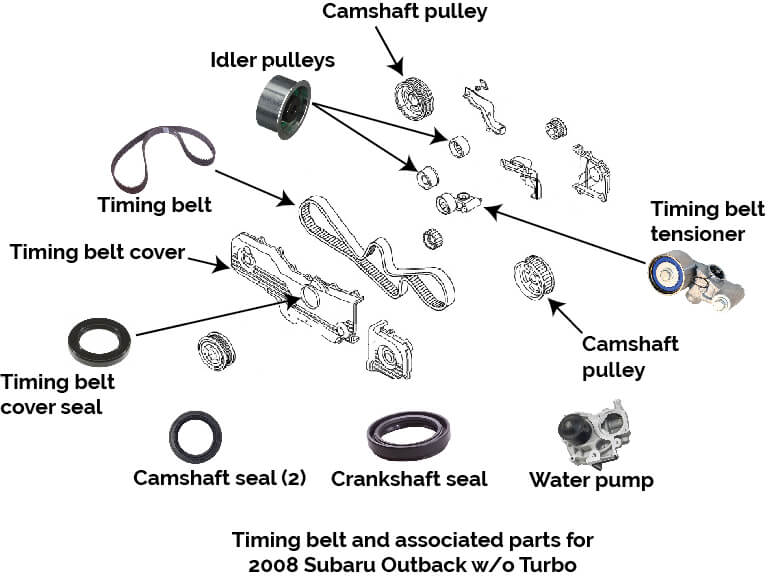What’s involved in timing belt replacement job?
Why you do a timing belt replacement job on time
Many vehicles with an overhead cam engine use a timing belt to rotate the camshafts. Those belts must be replaced periodically. The replacement interval varies by car maker and engine,  but common replacement intervals range from as
but common replacement intervals range from as 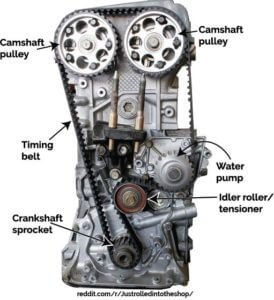 often as every 60,000 miles to as long as 110,000 miles. The interval depends not only on the design but also the type of rubber used in the timing belt itself.
often as every 60,000 miles to as long as 110,000 miles. The interval depends not only on the design but also the type of rubber used in the timing belt itself.
What is a timing belt?
A timing belt is a long ribbed belt that drives the camshafts in time with the crankshaft on overhead cam engines. 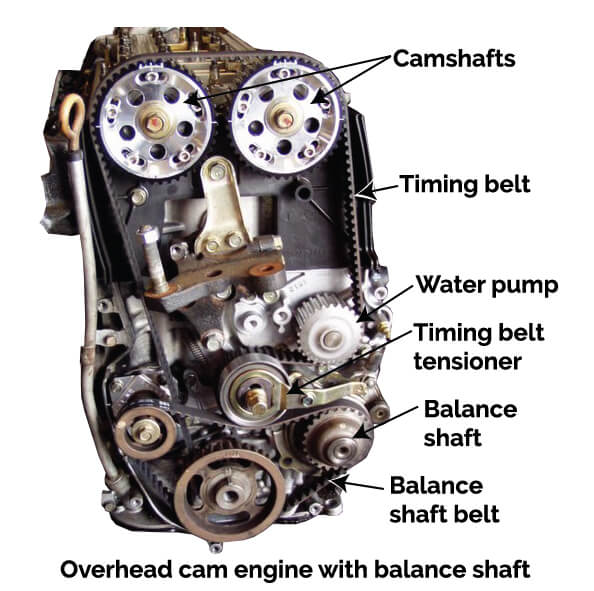 The older belt designs were made from neoprene/saturated nitrile rubber with fiberglass reinforcement cords. Neoprene can be damaged by heat and oil, so those older designs required replacement in 60,000 or 90,000 miles. Newer engines were designed to use ethylene propylene diene monomer (EPDM) rubber-like compounds that are more resistant to heat and oil, so they last longer.
The older belt designs were made from neoprene/saturated nitrile rubber with fiberglass reinforcement cords. Neoprene can be damaged by heat and oil, so those older designs required replacement in 60,000 or 90,000 miles. Newer engines were designed to use ethylene propylene diene monomer (EPDM) rubber-like compounds that are more resistant to heat and oil, so they last longer.
The timing belt system can consist of a single belt or multiple belts. In a multiple belt system, one belt drives the camshafts and the other belt drives the balance shafts.
Why is it so important to replace a timing belt at the recommended intervals?
Many engines are designed with a small clearance when the piston reaches the top of its travel. For example, once the piston reaches the top of its compression stroke, the intake and exhaust valves must be closed on most engines. If the camshaft is out of time with the crankshaft (timing belt has developed slack due to a faulty belt tensioner and the belt has skipped a tooth), the intake or exhaust valve may not be fully closed when the piston reaches the top of its travel. When that happens, the piston hits the valve(s) with tremendous force, damaging both the valve(s) and piston. These engines are referred to as an “interference engine.” If the timing belt breaks on an interference engine while it’s running, the result is often catastrophic engine damage costing around $2,500 to $4,000.
Other engines are designed with more space at the top of piston travel. Those engines can survive a broken or out-of-time timing belt. They’re referred to as “free-wheeling.” If the belt breaks while the engine is running, the valves will continue to open and close for a short while, but won’t contact the pistons. The engine will stop running however.
Regardless of the type of engine in your vehicle, ignoring the recommended timing belt replacement is never a good idea. If you have a free wheeling engine, a broken belt will cause a breakdown requiring a tow because the engine won’t restart after quitting. So you’ll be stranded until you can get it to a shop capable of performing a timing belt replacement. You’ll have to pay for the full timing belt replacement and the tow, so you won’t save any money by extending the timing belt change interval. If you have an interference engine, delaying an $800 timing belt replacement can cost you up to $4,000 once it breaks.
What else should you replace when replacing the timing belt?
The timing belt is kept taught by a timing belt tensioner. The tensioner usually contains a smooth idler roller that exerts pressure against the timing belt. Opting out of replacing the tensioner is a risky move—if it fails, it can cause the same type of damage as a broken timing 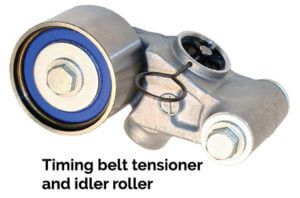 belt. Over time the timing belt can wear grooves into the idler roller and those grooves can cause premature damage to the new belt. In addition, the idler roller itself rotates on a bearing that can wear out. So it’s always a good idea to replace the tensioner and all idler rollers at the same time. In fact, most shops won’t provide a timing belt warranty unless you replace all those components together. Buying the belt, tensioner and idler rollers separately can cost far more than buying those components in a timing belt kit. If the shop estimate lists separate prices for the individual components, ask them to re quote the job using a timing belt kit—that should provide some savings.
belt. Over time the timing belt can wear grooves into the idler roller and those grooves can cause premature damage to the new belt. In addition, the idler roller itself rotates on a bearing that can wear out. So it’s always a good idea to replace the tensioner and all idler rollers at the same time. In fact, most shops won’t provide a timing belt warranty unless you replace all those components together. Buying the belt, tensioner and idler rollers separately can cost far more than buying those components in a timing belt kit. If the shop estimate lists separate prices for the individual components, ask them to re quote the job using a timing belt kit—that should provide some savings.
Should you replace the water pump when you replace the timing belt?
In many engines, the water pump is driven by the timing belt and the belt must be removed to replace the pump. Water pumps usually fail before the engine reaches 200,000 miles, so shops usually recommend replacing the water pump at the 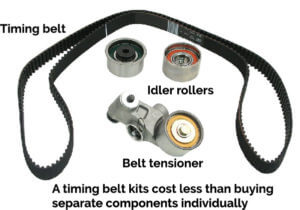 same time as the timing belt. The reasoning is that the bulk of the labor has been performed to remove the front portion of the engine and the timing belt. Once the timing belt is off, the only extra expense is the cost of the new pump and the labor to remove it and drain and refill the cooling system.
same time as the timing belt. The reasoning is that the bulk of the labor has been performed to remove the front portion of the engine and the timing belt. Once the timing belt is off, the only extra expense is the cost of the new pump and the labor to remove it and drain and refill the cooling system.
But the question still stands—should you replace the pump? Let’s say your vehicle requires a new timing belt at 90,000 mile and you plan to keep the vehicle until it no longer runs. Chances are your engine will need a new water pump before the next timing belt replacement job at 180,000 miles. If you don’t replace the pump at 90,000 miles and it fails, you’ll pay the full labor cost again. If you feel you might be in a better financial position at a later time, then opt out of the water pump replacement at 90,000 miles. Here’s a scenario where that thinking works to your advantage:
You replace just the timing belt at 90,000 miles. At 140,000 miles the shop informs 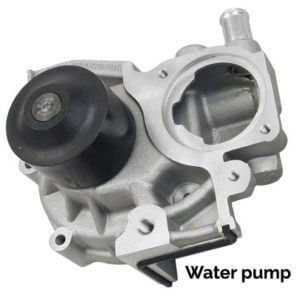 you that the water pump is leaking and must be replaced. You pay for both a new timing belt and a water pump. Yes, you’re replacing the belt early, but you’re also resetting the clock on the replacement interval. You’re now good until you reach 230,000 miles—which is most likely near the vehicle’s end of the engine’s life. In this situation, you come out ahead money-wise. If the pump fails sooner, then you’ll be on the losing end.
you that the water pump is leaking and must be replaced. You pay for both a new timing belt and a water pump. Yes, you’re replacing the belt early, but you’re also resetting the clock on the replacement interval. You’re now good until you reach 230,000 miles—which is most likely near the vehicle’s end of the engine’s life. In this situation, you come out ahead money-wise. If the pump fails sooner, then you’ll be on the losing end.
Should you replace the crankshaft and camshaft seals?
Both the crankshaft and camshaft are fitted with a metal/rubber seal to prevent oil from leaking out of the engine. Many shops recommend replacing these seals during a timing belt replacement since the bulk of the labor is 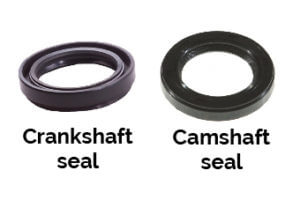 already done. The only added expense is the cost of the parts (usually less than $20) and about a half-hour of extra labor. Should you authorize the repair? If the technician informs you that the current seals are leaking, have them replaced. If the seals aren’t leaking chances are better than 50/50 they’ll never leak. If you opt out of this repair, you may come out ahead. But you have to be comfortable with the risk that they may leak before your next timing belt change.
already done. The only added expense is the cost of the parts (usually less than $20) and about a half-hour of extra labor. Should you authorize the repair? If the technician informs you that the current seals are leaking, have them replaced. If the seals aren’t leaking chances are better than 50/50 they’ll never leak. If you opt out of this repair, you may come out ahead. But you have to be comfortable with the risk that they may leak before your next timing belt change.
Should you have the cooling system flushed at the same time as a timing belt replacement?
If you’re having the water pump replaced, the technician will have to drain a portion of the cooling system. Since most car makers recommend a coolant change around 100,000 miles, shops also recommend a cooling system service at the same time. It’s a good idea, but only if the shop makes it a package deal. Remember, they have to drain a portion of the cooling system to replace the water pump. You should get a partial discount on the cooling system service if you’re getting the timing belt and water pump replaced at the same time.
How to avoid being ripped off when replacing a timing belt
Replacing a timing belt requires the removal of many parts from the front of the engine. In most cases the technician must remove the serpentine drive belts to the alternator, A/C compressor and power steering pump. Once the timing belt is removed, the bulk of the labor is already done for a water pump, camshaft, crankshaft seal replacement. Here’s an example of the flat rate labor times for a 2008 Subaru Outback
Labor hours to remove and replace the timing belt 2.3
If done at the same time, here are the extra flat rate labor hours
To replace the following parts
Crankshaft seal 0.5 hrs
Camshaft seals 0.4 hrs
Oil pump seal 0.5
Idler pulley 0.1 hrs
Timing belt tensioner 0.1 hrs.
Water pump 0.7 hrs.
So the total labor would come to 4.6 hrs.
Where you can get ripped off
Unscrupulous shops double dip on the flat rate labor charges. For example, they’ll charge you 3.9-hrs. to replace the timing belt, camshaft and crankshaft seals, oil pump seal and timing belt tensioner. But they’ll charge you an additional 3.0-hrs. to replace the water pump. As you can see above, if you replace the water pump when you’re doing the timing belt, the extra labor is only 0.7 hrs. The 3.0 -hr labor time is for replacing the water pump as a standalone repair, without a timing belt replacement. In another example, a shop may charge you 4.6-hrs. to replace the timing belt, seals, and water pump, but charge additional labor to replace the serpentine drive belts. But they have to remove and replace those belts as part of the labor to do the timing belt. If those serpentine drive belts are worn and you authorize the shop to replace them, you should be charged for the parts, but you shouldn’t be charged extra labor.
How can you tell what’s covered? Simple. Ask the shop to show you the flat rate guide. Here’s an example. The timing belt job for this Subaru shows the labor for the base timing belt job at 2.3-hrs. Then it lists the additional items as “combinations.” That’s the extra labor required to replace those components if you replace them at the same times as the timing belt.
Where’s the best place for a timing belt replacement?
Replacing a timing belt is labor intensive, so you may be tempted to avoid the dealer due to their higher hourly labor rate. However, installing a timing belt requires scrupulous attention to detail and engine-specific proper tools. If the technician isn’t familiar with the design of your engine, they can install the belt improperly, causing poor performance or damage. This is one of the few maintenance repairs where it may be in your best interests to use the dealer service department. Or, find an independent shop that specializes in your car make. Simply ask the shop how often they work on your car brand and how many times they’ve done a timing belt job on that particular engine. If they don’t routinely work on that brand, ask them for a recommendation of a shop that does.
©, 2016 Rick Muscoplat
Posted on by Rick Muscoplat

